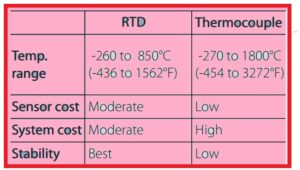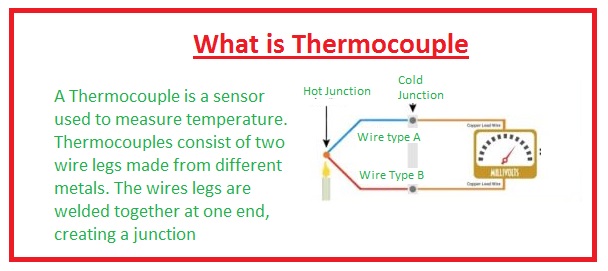 Hello, friends welcome to the new post. In this post, we will have a detailed look at Difference Between RTD and Thermocouple. both of these two instruments are used for the measurement of temperature. Also called temperature sensor there difference is the operation over which these two devices operate.
Hello, friends welcome to the new post. In this post, we will have a detailed look at Difference Between RTD and Thermocouple. both of these two instruments are used for the measurement of temperature. Also called temperature sensor there difference is the operation over which these two devices operate.
RTD consists of one metallic wire that resistance change measure the temperature and thermocouple uses two wires for temperature measurements. Here we cover the basics of these two devices with the details. So let get started with Difference Between RTD and Thermocouple.
Difference Between RTD and Thermocouple
What is RTD
- The RTD stands for resistance temperature detector type of sensor that used to finds the value of temperature.
- With the resistance increment, it measures the value of temperature.
- it is a passive module that does not generate any output.
- Any exterior device is employed to finds the resistance of any device when small value current is passed through it.
- Generally, one milliampere current is provided to this device to operate.
- The RTD is created through the use of numerous standards and curvatures and tolerances. The generally used curve for this module is DIn.
- That defines the relation between resistance and temperature of platinum.
- The construction of RTD is simple that comprises of wire wounded about the ceramic material.
- The wire of this device is created through pure substances like nickel, copper, etc.
- The material of wire should give an accurate value of resistance to temperature so temperature measurement from the instrument occurs accurately.
- Due to fragile nature used normally covered with the protection cover
RTD Types
- There are 3 main types of RTD first one thin film second one is wire wound and the third is in the form off coil are employed in the industrial level
Carbon RTD
- It is less costly and normally used in different applications. For low-value temperature measurements, it used. Since they offered less value for hysteresis.
Strain Free RTD
- It consists of a coil that exists in the cover having inert gases in that covering. It used to measure maximum value temperature to 961
- With the temperature increment, its structure can be expanded due to the usage of a platinum coil that is loose structure.
Thin Film RTD
- It consists of detection compone that is created through use of a thin sheet of resistance substance generally platinum.
- The thickness of a sheet or layer of platinum is one to ten nanometer. and layer has a coating of epoxy that provides protection to the device.
What is Thermocouple
- The thermocouple is an electrical instrument that comprises of 2 metallic rods of a different electrical conductor and makes an electric junction.
- The thermocouple generates a temperature-dependent voltage in consequence of the setback factor.
- The available thermocouple are costly and provided with connectors and has the ability to finds the value of temperature at different ranges.
- Its drawback is that there is a one-degree error that can exist in this device.
- This module is generally used in industrial providing different use like kilns, gas turbine and other types of different process used this device
- They can easily get through the electronic market with a less cost changeable facility and consists of standard level connectors and used to finds different values of temperature.
- The best feature is that they get power on a self basis not need any extra power source for them.
- Its drawback is that is less accurate it causes a fault in the case of measurement of temperature value less than one centigrade.
- They are employed in the industrial level and different laboratories.
- Used to measure the temperature of the kiln, gas turbine, engines, and different industrial processes.
- also used in homes, offices as temperature measurement deice in thermostat.
Comparison Between RTD and Thermocouple
That is a detailed post about Difference Between RTD and Thermocouple if you have any further query ask in comments. thanks for reading have a nice day. Thanks for reading.







